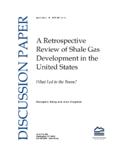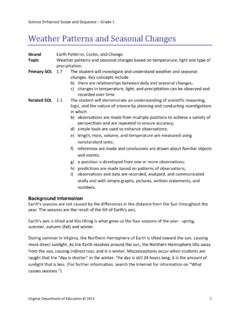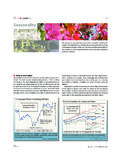Transcription of Terrestrial Ecosystem Adaptation - Resources for …
1 Terrestrial Ecosystem Adaptation Steven W. Running and L. Scott Mills RFF REPORT Adaptation | AN INITIATIVE OF THE CLIMATE POLICY PROGRAM AT RFF JUNE 2009 2 Table of Contents Introduction .. 1 Climatic Means versus Extremes .. 3 Recent Historical Climate Trends and Variability .. 4 Vegetation Response and Phenology .. 6 Wildfire and Disturbance .. 9 Adaptation to Climate Change in Wild Populations .. 11 Adaptation in Place via Plasticity and/or Evolution .. 12 Adaptation via Movement and Range Shifts .. 15 The Interaction of Climate Change with Other Human Caused Stressors .. 16 Expected Future Ecosystem Trends .. 17 Future Climate Trends .. 17 Species Responses Based on Focal Animal Species .. 19 Adaptation Options .. 23 Water Management .. 23 Vegetation Management .. 24 Manage for Resilience.
2 25 Facilitate Connectivity and Consider Assisted Colonization .. 25 Directed Evolution of Native Animals .. 26 References .. 27 RUNNING AND MILLS 1 terrestrial ecosystem adaptation Steven W. Running and L. Scott Mills* Introduction n this report, we evaluate Adaptation issues for natural ecosystems . We will specifically focus on the interactions with the abiotic environment of plants and animals, along with other organisms with which they interact ( , disease causing bacteria and viruses). We further limit ourselves to natural ecosystems in which the predominant vegetation has developed without having been planted, irrigated, or fertilized. Most of the natural lands in the United States are managed by federal or state governments. Agricultural lands including range grazing lands are dealt with in a related Adaptation report.
3 This will evaluate the potential magnitudes and challenges facing Terrestrial ecosystems in the United States in adapting to changing climate over the next 30 50 years. Our report will not address attribution or mitigation of climate change, as these topics have been dealt with in many other forums. We will begin with a brief summary of the current trajectory of the changing climate in the United States, including both temporal and spatial patterns. We will then relate these trends to Ecosystem impacts and vulnerabilities. We consider Adaptation in the broad sense to include any means by which organisms successfully confront a perturbation such as climate change. This includes both local Adaptation in place either through plastic responses or through evolutionary changes as well as changes in movements within or outside of the current geographic range.
4 Some species (often invasive and disease species) will adapt spectacularly. By contrast, those unable to adapt will experience decreased average mean fitness, translating into population decline, decreased persistence, and changed community and Ecosystem structure (Figure 1). After considering ecological Adaptation mechanisms, it becomes possible to consider potential management options to enhance Adaptation . We do not make recommendations of specific Adaptation activities at this point; rather, we suggest alternatives to begin the discussion. * Department of Ecosystem Sciences, College of Forestry and Conservation, University of Montana, Missoula, MT. This report was prepared for the Resources for the Future project on Adaptation to climate change.
5 For more information, see I RUNNING AND MILLS 2 Figure 1. Response of Biotic Communities as Climate Change Affects Individual Species (which adapt in place, move, or decline toward extinction), Changes in Species Interactions, and Ultimately the Structure and Composition of Communities and ecosystems Note: Differential Adaptation among species leads inexorably to changes in community and Ecosystem structure RUNNING AND MILLS 3 Climatic Means versus Extremes The biophysical and biogeochemical activity of a Terrestrial Ecosystem is physically constrained by the average meteorological conditions of the site. Processes like photosynthesis, respiration, transpiration, decomposition, and animal physiological responses react to the light, temperature, and water conditions that prevail throughout the growing season and, in some cases, the winter dormant season.
6 In contrast, the mortality of an individual organism can be triggered by an instantaneous extreme event a freezing or heat threshold or loss of critical hydration. Consequently, the responses of ecosystems to changing climates must pay attention to annual and seasonal averages as well as changing probabilities of extreme events (Figure 2). Figure 2. Principles of the Importance of Changing Probabilities of Climatic Extremes for Ecosystem Adaptations Source: IPCC 2007. RUNNING AND MILLS 4 For plants and animals, the climate extremes may be more important than changes in averages. Both high and low temperatures are potential mortality points on which natural selection will act for different organisms. Low temperature mortality points typically involve late spring or early autumn frosts that are abnormal in their seasonal timing more than their absolute temperature.
7 Midwinter conditions rarely harm native plants because they are in their deepest dormancy at that time of year. High temperature mortality more directly kills organisms that reach the common 55 C protein denaturation point. Although 55degC would be a nearly impossible weather station temperature in the it is a common surface temperature in midsummer. An increasing magnitude of environmental variation also has a less appreciated, but potentially powerful, effect on likely population growth rates, or trends, of plants and animals. Because population growth is a multiplicative process, the most likely long term growth rate in a stochastic (variable) environment is governed by the geometric mean. As variance in the birth and death rates that make up population growth increases, the geometric mean growth rate becomes progressively smaller then the arithmetic mean.
8 In practice, this means that increased variability in climate conditions will tend to decrease expected population growth rates; short lived species will tend to be affected in more volatile ways by this phenomenon. Importantly, this effect of variability on expected population growth is independent of any changes in the mean rates. Recent Historical Climate Trends and Variability For the annual mean air temperature in the contiguous United States, the increase was about per 100 years from 1895 to 2002 (Figure 3 and Zhang et al. 2000; Groisman et al. 2004, ). Most of the warming has occurred in the spring and winter (Dole et al. 2008; Bonsal et al. 2001). Minimum ( , nighttime) temperatures have warmed more rapidly than maximum ( , daytime) temperatures (Easterling et al. 1997; Zhang et al.)
9 2000; Bonsal et al. 2001). Annual total precipitation in the United States has increased 7 percent (Groisman et al. 2004 and Figure 4). A recent analysis of long term daily precipitation records (1895 to 2000) in the United States by Kunkel et al. (2004) found that heavy precipitation frequencies were at a minimum in the 1920s and 1930s and then increased in the 1990s. Groisman et al.(2004) reported increases in heavy and very heavy precipitation in the conterminous United States during the past three decades. During the past few decades of the 20th century, a greater proportion of the United States was either in severe drought or severe moisture surplus (Zhang et al. 2000a). Dai et al. (2004) found that global land areas in either very wet or very dry conditions increased from 20 to 38 percent of land area since 1972, suggesting more extreme hydrology.
10 Stream flow has increased 25 percent in the past 60 years over the eastern United States (Groisman 2004) but has decreased in the western United States about 2 percent per decade in the past century (Root et al. 2005). Walter et al. (2004) calculate that evapotranspiration has increased 55 millimeters in the last 50 years in the conterminous United States; however, their data show reduced stream discharge in the Colorado and Columbia River basins since 1950. RUNNING AND MILLS 5 Figure 3. Trends in Annual Air Temperatures for the United States Source: National Oceanic and Atmospheric Administration, National Climate Data Center (NCDC). Figure 4. Trends in Annual Precipitation for the United States from 1901 to 2006 Source: National Oceanic and Atmospheric Administration, National Climate Data Center (NCDC).

















